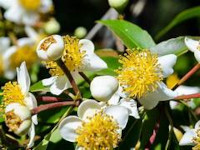Xanthine Oxidase Inhibitory Activity of Xanthones from Calophyllum pseudomole P. F. Stevens http://www.doi.org/10.26538/tjnpr/v8i1.31
Main Article Content
Abstract
The genus Calophyllum (Calophyllaceae) is a plant proven to produce various xanthones, chromanoic acids, and 4-phenyl coumarins. This study aims to determine the xanthine oxidase inhibitory activity of xanthones from Calophylum pseudomole P.F. Stevens. Two xanthones, ananixanthone (1) and caloxanthone L (2), were isolated from Calophyllum pseudomole stem barks. The structures of both xanthones were determined based on UV, HRESI-MS, 1D, and 2D NMR spectral data. Compounds 1-2 showed xanthine oxidase inhibitory activity with an IC50 of 15.05 and 17.7 μM, respectively, and were categorized as potent.
Downloads
Article Details

This work is licensed under a Creative Commons Attribution-NonCommercial-NoDerivatives 4.0 International License.
References
Falodun A, Qadir MI, Chouldary, MI, Isolation and characterization of xanthine oxidase inhibitory constituents of Pyrenacantha staudtii. 2009; Acta Pharm Sin, 44(4), 390-394.
Juanda D, Fidrianny I, Wirasutisna KR, Insane M. Evaluation of xanthine oxidase inhibitory and antioxidant activities of three organs of idat (Cratoxylum glaucoma korth.) and correlation with phytochemical content. 2021; Pharmacogn.J, 13(4), 971–976.
Kostić DA, Dimitrijević DS, Stojanović GS, Palić IR, Dordević AS, Ickovski JD. 2015. Xanthine oxidase: isolation, assays of activity, and inhibition. 2015; J. Chem. 1-8
Pacher P, Nivorozhkin A, Szabo A. Therapeutic effects of xanthine oxidase inhibitors: renaissance half a century after the discovery of allopurinol. Pharmacol. Rev., 2008; 58(1), 87-114.
Hu L, Hu H, Wu W, Chai X, Luo J, Wu Q. Discovery of novel xanthone derivatives as xanthine oxidase inhibitors. Bioorg. Med. Chem. Lett. 2011; 21(13), 4013–4015.
Shaffique S, Ahmad S, Rehman T, Anwar H, Hussain G. Antihyperuricemic activity of gum of Calophyllum inophyllum ultra high dilutions in potassium oxonate induced wister albino rats. Indian J. Trad. Knowl. 2019; 18(2), 356-359
Tanjung, M., Saputri, R. D., Tjahjandarie, T. S. 5,9,11-Trihydroxy-2,2- dimethyl-10-(3′-methyl-2′-butenyl)-3-(2″-methyl-3″-butenyl)pyrano[2,3- a]xanthen-12(2H)-one from the stem bark of Calophyllum pseudomole. MolBank, 2016; 2016(3), 1-5.
Tanjung M, Rachmadiarti F, Prameswari A, Agyani VUW, Saputri RD, Tjahjandarie TS, Syah YM. Airlanggins A-B, two new isoprenylated benzofuran-3-ones from the stem bark of Calophyllum soulattri. Nat Prod Res. 2018; 32(13),1493-1498.
Tanjung M, Tjahjandarie TS, Saputri RD, Kurnia BD, Rachman MF, Syah YM. Calotetrapterins A-C, three new pyranoxanthones and their cytotoxicity from the stem bark of Calophyllum tetrapterum Miq. Nat Prod Res. 2021; 35(3),1256-1261.
Tanjung M, Tjahjandarie TS, Saputri RD, Aldin MF, Purnobasuki H. Two new pyranoxanthones from the stem bark of Calophyllum pseudomole P.F. Stevens. Nat Prod Res. 2022; 36(3), 822-827.
Tjahjandarie TS, Tanjung M, Rachmania DF, Rhidoma CI, Saputri RD. Calodioscurins A and B, two new isoprenylated xanthones from the stem bark of Calophyllum dioscurii P.F. Steven. Nat. Prod. Res, 2021; 35(7), 1153-1158.
Tjahjandarie TS, Nugroho WAS, Palgunadi H, Saputri RD, Tanjung M. Two new chromanone acids from the stem bark of Calophyllum peekelii (Lauterb). Nat. Prod. Res. 2023; 37(19), 3214-3219.
Yimdjo MC, Azebaze AG, Nkengfack AE, Meyer AM, Bodo B, Fomum ZT. Antimicrobial and cytotoxic agents from Calophyllum inophyllum. Phytochem. 2004; 65(20), 2789–2795.
Lim CK, Subramaniam H, Say YH, Jong VYM, Khaledi H, Chee CF. A new chromanone acid from the stem bark of Calophyllum teysmannii. Nat Prod Res. 2015; 29,1970-1977.
Shen Y-C, Wang L-T, Khalil AT, Chiang LT, Cheng PW. Bioactive pyranoxanthones from the roots of Calophyllum blancoi. Chem Pharm Bull. 2005; 53, 224-247.
Hay A-E, Helesbeux J-J, Duval O, Labaied M, Grellier P, Richomme P. Antimalarial xanthones from Calophyllum caledonicum and Garcinia vieillardii. Life Sci. 2004; 75, 3077-3085.
Saputri RD, Retnowati R, Supratman U, Tjahjandarie TS, Tanjung M. Three novel quinolinone alkaloids from the leaves of Melicope denhamii. Nat. Prod. Res. 2023; 37 (2), 197-203.
Tjahjandarie TS, Tanjung M, Saputri RD, Aldin MF, Susanti RA, Pertiwi NP, Wibawa RS, Halizah IN. Cytotoxicity evaluation of two new chalcones from the leaves of Flemingia macrophylla (Willd.) Merr. Phytochem. Lett. 2021; 44, 78-81.
Tjahjandarie TS, Tanjung M, Saputri RD, Nadar PB, Aldin MF, Permadi A. Flavestin K, an isoprenylated stilbene from the leaves of Macaranga recurvata Gage. Nat Prod Sci. 2019; 25(3), 244-247.
Tanjung M, Tjahjandarie TS, Aldin MF, Aldin MF, Mardhiyyah S, Maqfiroh I, Saputri RD, Ahmat N. Xantones and 4-phenylcoumarins from the twigs of Mesua beccariana (Baill.) Kosterm. Nat. Prod. Sci. 2023; 29(1), 38-41.
Mardhiyyah S, Zakiyah M, Renata ED, Tjahjandarie TS, Supratman U, Retnowati R, Saputri RD, Tanjung M. Cytotoxic activity of xanthones from the stem bark of Cratoxylum sumatranum and their cytotoxic activity, Trop. J. Nat. Prod. Res, 2023; 7(9), 3908-3910.


